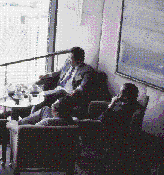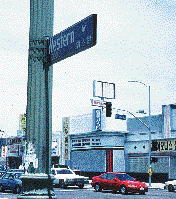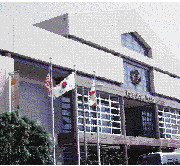ASIAN CALIFORNIA
Page 10 of 12
Corean Americans:
AT HOME IN LOS ANGELES
 oreans are the youngest of the three major California Asian groups.
The first generation still makes up roughly 85% of the Corean American
population and 90% of the adult workforce. But in the short time they've
been here, the Coreans have left an indelible economic mark and have
offered marked testimony to a city's jealous rage.
oreans are the youngest of the three major California Asian groups.
The first generation still makes up roughly 85% of the Corean American
population and 90% of the adult workforce. But in the short time they've
been here, the Coreans have left an indelible economic mark and have
offered marked testimony to a city's jealous rage.
| "Koreatown is one of the brightest spots in the entire Los Angeles economy. New business growth is stagnant in all parts of Los Angeles compared to what is going on in Koreatown." |
This small band of Corean patriots who managed to escape Corea and actually visit the White House trusted in America and believed that not only would her president hear them out, but that he would take action against imperialistic Japan as well. The brave delegates were kept waiting all day.
Finally, a secretary informed them that the president would be unable to see them. Would they like to leave a message, she asked.
Once again, the pattern of discrimination and repression reared its ugly head.
Most states barred Coreans from owning or leasing land until after WWII and until 1952, Coreans couldn't become naturalized citizens. By 1969 there were less than 40,000 Coreans in the entire country. Many of them were war brides from the Korean war or orphans adopted by empathetic servicemen. Others, like the Chinese before them, had fled the Communists in the early '50s. But the passage of the Immigration Act of 1965 significantly raised the quotas on newcomers from Asia and a whole new wave of Coreans hit California's shores. More importantly, the 1965 law gave preference to those Asians who were highly educated and in possession of engineering or scientific skills.
Corean immigrants achieved success in California faster and more completely than any other previous wave of Asians. By the mid-'70s, 28,000 Coreans per year immigrated. A third of them settled in Los Angeles, working low-paying jobs and toiling until they could save enough money to open their own businesses. They lived in rundown apartments in the Mid-City district of Los Angeles, where the byways of Olympic, Crenshaw, Beverly, Western and Vermont Avenues created a swirling vortex of new businesses and new energies. When the Corean government raised the export restrictions on capital from $5,000 to $100,000, larger stores, strip malls and entertainment centers, all adorned with the traditional Corean hangul characters, solidified Koreatown's success.
"Koreatown is one of the brightest spots in the entire Los Angeles economy," says Jim Choi, 25, executive director of the Los Angeles Korean Chamber of Commerce. "New business growth is stagnant in all parts of Los Angeles compared to what is going on in Koreatown. Koreatown in Los Angeles--the biggest Corean enclave of its kind in the United States--is a vital area that will push the economy of Los Angeles forward in the next few years."
A recent survey by the city's Visitor and Convention Bureau depicts Koreatown as a hugely popular destination for Corean tourists. The typical tourist couple will spend about $2,000 on products and services during their visit, most of it in Koreatown, over the course of approximately 10 days, he says.
 (Top to bottom): Corean corporations have
bought up many visible Koreatown properties along Wilshire Boulevard,
riding the prosperity and turning the district into a Corean financial base;
Western and Olympic is the southeast corner of Koreatown;
(Top to bottom): Corean corporations have
bought up many visible Koreatown properties along Wilshire Boulevard,
riding the prosperity and turning the district into a Corean financial base;
Western and Olympic is the southeast corner of Koreatown;

Koreatown Plaza, a newer upscale shopping mall on Western, is a Koreatown landmark. 
|
The Korean American Chamber of Commerce will be busy building bridges between Corean American businesses and the broader business community in and around Los Angeles, says Choi. At the moment, the chamber is attempting to facilitate the efforts of some of its members who want to create a free-trade zone adjacent to the Port of Long Beach. Import-export companies that relocate there would find it possible to defer paying duties and other excises on goods until after they are sold, rather than upon arrival from overseas.
Koreatown--the biggest Corean enclave of its kind in the United States--is a vital area that will push the economy of Los Angeles forward in the next few years. Page 11
| Page 1 | 2 | 3 | 4 | 5 | 6 | 7 | 8 | 9 | 10 | 11 | 12 |
CONTACT US
|
ADVERTISING INFO
© 1996-2013 Asian Media Group Inc
No part of the contents of this site may be reproduced without prior written permission.
